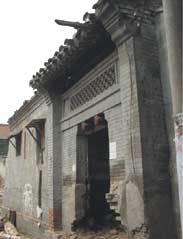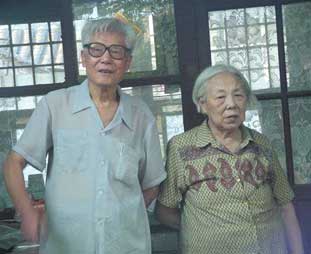 By Jia Hepeng By Jia Hepeng
Li Yan'nng, a 80-year-old Beijing resident in the downtown Jiaodaokou Avenue of the city's Dongcheng District, had to leave his century-old house which was bought by his father some 70 years ago.
Together with the whole traditional alleyway, or hutong, Li's house had been leveled to develop a luxury high-rises as a result of the government's efforts to "Beautify"?the city in the wake of its successful bid for the 2008 Olympic Games.
The hutong, with a fair-sounding Chinese name "Tu'er,?was demolished in August, and now groundwork for six 13-story apartments has been completed. Within the year, a new residential zone of modern style will totally replace vestiges of the hutong marked by the flying eaves, grey walls, varied door stilts, and even neighbours?chatting and quarrels.
In Beijing government's massive "city beautification"?project to replace old and dangerous houses with polished apartments, 70,000 households had to abandon their residences in the past 12 months, a large portion of which were built more than one hundred years ago.
The fate of old houses nationwide is no better than in Beijing. Though national statistics are unavailable, the massive urban renovation project and the booming real estate market have erased millions of traditional buildings and thousands of streets.
While some city officials are jubilant over their achievements to improve urban trafficand refine city environments, cultural relic protectionists, including architects, historians, and journalists, worry that historic relics and traditional streets would disappear rapidly.
"In fact, most traditional streets in major cities have disappeared,?said Wang Jinghui, a senior architect and the director of the National Committee of Well-known Historic City Protection. "We have to extend our notice downward to salvage those smaller historic towns.
ang's remark was made in a seminar held in March. In July, four months after his speech, Beijing's successful Olympic bidding stimulated a new round of demolition and construction in the capital city's old urban areas.
The destruction of traditional lifestyle
Experts say that many city officials and planners considered wide avenues, high luxury buildings and spacious urban squares as the standard image of modern cities. Historic relics surviving in such environments are just a number of palaces or royal parks such as the Forbidden City or the Summer Palace that are ranked in the protection list. Beijing's municipal government has enhanced its efforts to widen avenues for smoother traffic and beautified facades at the cost of the demolition of more old houses and streets.
 Zheng Xiaoxie, top consultant to the Ministry of Construction, claimed that the urban government should first consider limiting traffic if necessary rather than demolishing traditional hutongs in Beijing.
Zheng Xiaoxie, top consultant to the Ministry of Construction, claimed that the urban government should first consider limiting traffic if necessary rather than demolishing traditional hutongs in Beijing.
"After they are destroyed, they will totally disappear, but cars can be limited outside the old urban areas to reduce traffic pressures,?said Zheng, a prominent architect.
What disappeared are not only those old buildings, but also traditional urban life in those alleyways and houses.
Before they moved out, residents in Tu'er HutongswheresLi Yan'nng lived kept a calm but cozy life. In the morning, after seeing their children go to work, elder residents would carry their birdcages for a walk. At summer nights, family members and neighbours would squat together in their small yards for suppers. Although community-based performance of Peking Opera had been replaced by TV sets, the simple life styles and close communications remained unchanged as a whole.
About 150 years ago, a Manchurian novelist Wen Kang wrote a popular novel "The Legend of Heroes and Their Lovers,?which vividly described the hutong's lifestyle and Beijing's oral languages.
But all these have been uprooted by bulldozers.
Zhang Jie, a professor with Tsinghua University's School of Architect, we said Beijing should think beyond the Olympics. He suggested building a new city centre to the east or south of urban Beijing to rechannel investment and unclog traffic.
Major reasons attributing to the destruction
Zhang's idea was not new. It has been suggested by Liang Sicheng (1901-1972), one of the founders of China's modern architecture, some 50 years before, when the People's Republic of China was newly founded.
However, the desire to industrialize China was much more impressing than preserving the traditional face of major cities. In 1950s, asgroupsof Soviet Union-style mansions were erected in the centre of historic cities like Beijing and Xi'an. In the 1960s, Beijing's 600-year-old ramparts were demolished to construct the Second Ring Road.
"The roots of current destruction of China'straditional urban face was planted in 1950s,?said Fan Yaobang, the general engineer of the Beijing Urban Planning Academy.
But greater demolition of old urban buildings in China took place in the country's fast economic development in the 1990s.

Rapid real estate development was considered a major reason leading to the destruction.
Traditional streets commonly lie in the downtown areas of Chinese cities. To substitute them with commercial facilities and apartments means great profits to real estate developers.
"After receiving bribes from developers, many city officials have become their representatives in the government who would follow developers?intentions to reshape old urban areas,?said Zhao Zhongshu, an expert with the protection committee.
In the urban renovation projects, many local governments lack money to develop old city areas. They have to rely on the investment of developers who prefer to replace old houses of low commercial value with new and high buildings for a better return.
Ironically, the government has seemingly enough excuses to demolish old houses: it is responsible for improving residents?living standards.
In China's industrialization process, especially during the Cultural Revolution (1966-76) which trampled basic human rights, large population of workers, or proletarians, were relocated by the government to many private traditional houses. As a result, a courtyard was often filled by several households.
To increase living areas of households in the traditional courtyards, the government should have constructed more buildings. But to construct more building, the government had to work with developers to demolish the old houses.
 "It has become a vicious cycle,?said Hua Xinmin, a French-Chinese protectionist who has been struggling for years to safeguard old buildings in Beijing. "It has become a vicious cycle,?said Hua Xinmin, a French-Chinese protectionist who has been struggling for years to safeguard old buildings in Beijing.
The cost to improve facilities of old houses, such as drainage and fire-prevention, is much greater than to build new apartments. The government has to construct additional buildings to locate overpopulated residents in old houses while investing to upgrade the antique buildings?facilities.
"To submit the task to developers is an easy job, but it is a crime committed to our offspring,?said Hua.
The government does strive for a better protection of old houses. According to Fan, a general plan for the aegis of Beijing's historical layouts and traditional streets would be worked out in the first half of this year. Twenty-five areas of traditional streets would be strictly protected in the plan, accounting for 27 percent of old urban areas.
Even though, many architects still warned that the protection sphere of the plan might be too narrow and the focus of it might lie in the maintenance of royal and noble constructions instead of traditional civilian streets.
"The face of old Beijing is embodied not only in palaces of emperors and their ministers, but also in low but characteristic civilian houses,?said Shu Yi, a famous literary critic and an advocate for the protection of old houses.
Other experts complaint that the lack of a specialized law to protect traditional houses and streets is an important factor for the failure to protect old houses.
"The current Cultural Relic Protection Law only safeguards those being listedsintosthe protection lists, but more traditional houses are beyond the sphere of the law,?said Wang of the protection committee.
In the past three years?plenary meetings of the National People's Congress, as a result of representatives?repeated proposal to make the law, the legislature has promised to work out the law soon.
But as China entered the World Trade Organization (WTO), which required massive legal amendments and adjustments, the schedule to make the law has been postponed.
In the situation, appeals of experts and media's critical reports play an active role to protect old streets.
But most of them failed. In 2000, nationwide reports on the destruction of old streets in Zhejiang Province's Dinghai and the demolition of a traditional courtyard in Beijing did not change the fates of those antique buildings.
The respect of property rights as a basic way to save old houses
Though there is no specialized law to protect traditional streets and houses, legal ways to save them from damage do exist.
Many residents have property rights of the houses they live in. "If these rights are fully respected, the demolitian of traditional houses could be slowed,?Hua said.
She estimated that there are 510,000 old houses in Beijing. If these house owners are allowed to ask for a price in accordance to market situation, the cost to develop old houses would be much increased, so as to discourage developers to demolish those old houses to build new ones.
Experts also proposed the privatization of existing old houses for their protection.

"If residents enjoyed the property right of the houses they lived in, they would have greater stimulus to protect them and improve their facilities on their own behalf,?said Shu Yi.
But the fact is that the property right has been despised in purpose or not.
In China, the right to decide relocation of residents and demolition of certain areas of urban buildings belongs to local governments in accordance with urban planning scheme. The government sets a compensation standard for those houses to be demolished, which residents often complainted was too low to afford a new apartment nearby.
In the case of the downtown Tu'er Hutong, each square metre of construction area of residents?houses was compensated at 5950 yuan (US.4). But each square metre of most high-rises in downtown Beijing is sold at more than 7,000 yuan (US). Most households lived in an area smaller than 30 square metres, which means the compensation fee they received was far from enough to buy an apartment in high buildings in downtown area.
In the past years, the compensation between those living in a house and the house owners differed very little.
However a new regulation on urban relocation released by the State Council in June stipulates that compensation should mainly go to house owners than house lessees, but the right to make the price was still controlled by local governments.
The price of land use right of private house owners has long been neglected.
In 1982, when the current Constitution was made, all urban land in China was reclaimed by the State, but the original house owners legally hold the land use right which was later allowed to be traded in the market in the 1988's amendment to the Constitution.
However, local governments and developers have never attempted to pay for house owners?land use right.
"Commonly speaking, the price of land use right is much bigger than the value of the house's structure in the land, especially in big cities like Beijing,?said Luo Qichun. Luo is a lawyer who has represented more than 20,000 householdsshavingsbeen relocated in Beijing to require the government to pay for the land use rights. So far, the case has not been accepted by the city's court yet.
"With current massive urban renovation, the government of course could not afford the price for land use right,?said Luo.
He was echoed by Hua. "If the house property and the land use right are fully respected, the government and developers?insufficient money to pay for the rights could become the biggest safeguard to save the old houses from being demolished,?she said.
| ![]() 本网站由北京信息港提供网络支持
本网站由北京信息港提供网络支持
 By Jia Hepeng
By Jia Hepeng
 Zheng Xiaoxie, top consultant to the Ministry of Construction, claimed that the urban government should first consider limiting traffic if necessary rather than demolishing traditional hutongs in Beijing.
Zheng Xiaoxie, top consultant to the Ministry of Construction, claimed that the urban government should first consider limiting traffic if necessary rather than demolishing traditional hutongs in Beijing.
 "It has become a vicious cycle,?said Hua Xinmin, a French-Chinese protectionist who has been struggling for years to safeguard old buildings in Beijing.
"It has become a vicious cycle,?said Hua Xinmin, a French-Chinese protectionist who has been struggling for years to safeguard old buildings in Beijing.